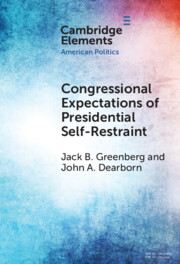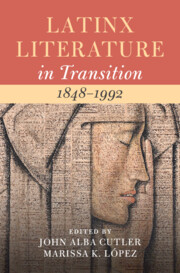51520 results in American studies
Chapter 7 - The Camaraderie of Influence
- from Part II - Being
-
-
- Book:
- Latinx Literature in Transition, 1848–1992
- Published online:
- 10 April 2025
- Print publication:
- 17 April 2025, pp 126-142
-
- Chapter
- Export citation
Contributors
-
- Book:
- Latinx Literature in Transition, 1848–1992
- Published online:
- 10 April 2025
- Print publication:
- 17 April 2025, pp xiii-xviii
-
- Chapter
- Export citation
Chapter 1 - José Garcia Villa’s Sojourn in New Mexico
- from Part I - Space
-
-
- Book:
- Latinx Literature in Transition, 1848–1992
- Published online:
- 10 April 2025
- Print publication:
- 17 April 2025, pp 19-36
-
- Chapter
- Export citation
Part I - Space
-
- Book:
- Latinx Literature in Transition, 1848–1992
- Published online:
- 10 April 2025
- Print publication:
- 17 April 2025, pp 17-92
-
- Chapter
- Export citation
Dedication
-
- Book:
- Latinx Literature in Transition, 1848–1992
- Published online:
- 10 April 2025
- Print publication:
- 17 April 2025, pp vii-viii
-
- Chapter
- Export citation
Copyright page
-
- Book:
- Latinx Literature in Transition, 1848–1992
- Published online:
- 10 April 2025
- Print publication:
- 17 April 2025, pp vi-vi
-
- Chapter
- Export citation
Chapter 18 - The Work of War
- from Part V - Labor
-
-
- Book:
- Latinx Literature in Transition, 1848–1992
- Published online:
- 10 April 2025
- Print publication:
- 17 April 2025, pp 315-332
-
- Chapter
- Export citation
Acknowledgments
-
- Book:
- Latinx Literature in Transition, 1848–1992
- Published online:
- 10 April 2025
- Print publication:
- 17 April 2025, pp xix-xx
-
- Chapter
- Export citation
Chapter 19 - Farmworker Culture in Literature and Film, or Tomás Rivera’s Brown Noir
- from Part V - Labor
-
-
- Book:
- Latinx Literature in Transition, 1848–1992
- Published online:
- 10 April 2025
- Print publication:
- 17 April 2025, pp 333-348
-
- Chapter
- Export citation
Chapter 14 - Modernism’s Workshops
- from Part IV - Form
-
-
- Book:
- Latinx Literature in Transition, 1848–1992
- Published online:
- 10 April 2025
- Print publication:
- 17 April 2025, pp 242-259
-
- Chapter
- Export citation
Chapter 2 - Latinx Internationalism, French Orientalism, and a Nuyorican Morocco
- from Part I - Space
-
-
- Book:
- Latinx Literature in Transition, 1848–1992
- Published online:
- 10 April 2025
- Print publication:
- 17 April 2025, pp 37-53
-
- Chapter
- Export citation
Part IV - Form
-
- Book:
- Latinx Literature in Transition, 1848–1992
- Published online:
- 10 April 2025
- Print publication:
- 17 April 2025, pp 225-294
-
- Chapter
- Export citation
Introduction
-
- Book:
- Latinx Literature in Transition, 1848–1992
- Published online:
- 10 April 2025
- Print publication:
- 17 April 2025, pp 1-16
-
- Chapter
- Export citation
Part II - Being
-
- Book:
- Latinx Literature in Transition, 1848–1992
- Published online:
- 10 April 2025
- Print publication:
- 17 April 2025, pp 93-160
-
- Chapter
- Export citation

Apartheid Spies and the Revolutionary Underground
-
- Published by:
- Wits University Press
- Published online:
- 16 April 2025
- Print publication:
- 01 November 2024

Congressional Expectations of Presidential Self-Restraint
-
- Published online:
- 15 April 2025
- Print publication:
- 31 May 2025
-
- Element
-
- You have access
- HTML
- Export citation
Lillian Smith's Strange Fruit and Periodical Readerships
-
- Journal:
- Journal of American Studies , First View
- Published online by Cambridge University Press:
- 11 April 2025, pp. 1-21
-
- Article
-
- You have access
- Open access
- HTML
- Export citation

Latinx Literature in Transition, 1848–1992
-
- Published online:
- 10 April 2025
- Print publication:
- 17 April 2025
References
-
- Book:
- Corruption in America
- Published online:
- 21 March 2025
- Print publication:
- 03 April 2025, pp 169-202
-
- Chapter
- Export citation
6 - Environmental Outcomes
- from Part II - What Difference Does It Make? Consequences of Corruption
-
- Book:
- Corruption in America
- Published online:
- 21 March 2025
- Print publication:
- 03 April 2025, pp 97-109
-
- Chapter
- Export citation

